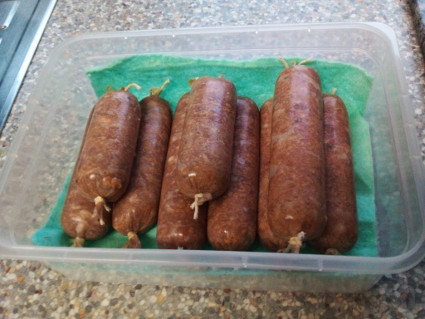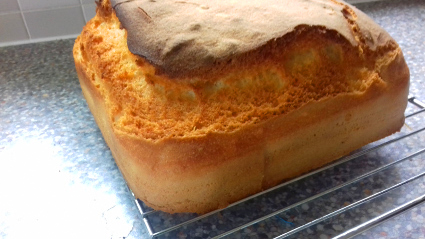
This is a totally made up recipe. I appreciate it doesn’t look pretty at any stage so far, but cured meats are all about flavour - not appearances.
The main thing about long curing and dehydrating is to make sure that your Salt and Saltpetre concentrations are sufficient to ensure there is no bacterial growth. Clostridium Botulinum is not a welcome friend. Botulism is no laughing matter. A bit of white residue on the outside of the casings at this stage in nothing to worry about, it’s just Salts crystallizing as they migrate through the permeable skins.
Please note that the weight for the curing Salts are per 1Kg. If your scales only measure to 2g, like ours, you’ll need to subdivide the measures to match the weight of meat you are working with.
Ingredients:-
400g of very fatty Pork. We used Belly Pork with the rind removed.
22.5g of Salt - Per 1kg
2g of Saltpetre - Per 1kg
175Ml of cheap Red Wine
40 Black Peppercorns, simmered to soften and drained
2 Tbsp of Hot Smoked Paprika
2 Tbsp of Paprika
3 Tbsp of Cayenne Pepper
Method:-
(1) Simmer and drain your Peppercorns, set aside to cool.
(2) Roughly cut the Pork so it will go through the Mincer / Extruder.
(3) Mince into a large bowl.
(4) Add all the other ingredients and mix by hand very well.
(5) Remove the cutting blade and plate from the Mincer.
(6) Feel the mixture through the Mincer and us the nozzle to extrude into Sausage Casings.
(7) Twist and cut into suitable lengths and tie off with string.
(8) Place in your dehydration box and change the desiccant as required.
(9) Allow 2 months to fully cure and dehydrate.
We started this in the 18th of December and it’s the 8th of January tomorrow. So we’ve had nearly 1 month curing and dehydrating. They now feel quite firm to the touch but still a little spongy in the middle if you press hard. So another month should do the job. I’ve created a little drying chamber with an air tight box and Silicone desiccant crystals which I pack the around the paper covered Pepperizo. I changed the desiccant every other day for the first couple of weeks. We’re now down it once a week as the greater part of the moisture has now migrated from the meat.


